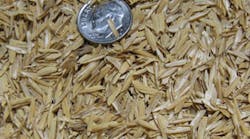Ford Motor Co. recently announced that it’ll use a resin crafted from rice hulls – a usually discarded byproduct of plain old rice grain – to reinforce the plastic coating shielding the electrical harnesses within its 2014 model F-150 pickup.
John Viera, Ford’s global director of sustainability and vehicle environmental matters, noted that the OEM needs at least 45,000 pounds of hulls in the first year to accomplish this material changeup and will be sourcing those hulls from farms in Arkansas to replace a talc-based reinforcement made from a polypropylene composite.
[In fact, the OEM is working with everything from soybeans to "retired" paper currency in its effort to boost recycled material content in its vehicles, as the video from Ford's Plastics and Biomaterials team below illustrates.]
David Preston, director of business development for Ford supplier RheTech, based in WI, said his firm is making the rice hull-based material for the OEM and said it took a total of three years of thorough testing before it became approved for use.
Indeed, Carrie Majeske, Ford’s product sustainability manager, stressed that is why even as the OEM’s researchers constantly searching for all sorts of sustainable materials that can feasibly be used to build a wide range of vehicles – including light trucks like the F-150 – finding a source of material represents only the very beginning of the process.
“Before making it to production, components made from recycled content must perform as well or better than comparable virgin-grade material,” she pointed out, noting that engineers at Ford Materials Engineering, Testing and Standards in Dearborn, MI, in conjunction with RheTech, conducted joint testing of the rice hull material, examining everything from smell and appearance to functionality and flammability.
[On a related tangent, check out the story below about Tony Roko, a safety painter, who learned to use “repurposed industrial materials” not only to create murals that beautify Ford's plants and factories but to create commercial art and help teach art to inner city kids as well.]
Yet rice hulls aren’t the only recycled or organic-based material Ford is using within its F-150 line. Here are some of the others:
- Recycled cotton: Used as carpet insulation and a sound absorber; in fact, every 2014 F-150 contains enough recycled cotton to make the equivalent of 10 pairs of jeans, according to Ford. Indeed, the OEM estimates about 10 million pounds of recycled cotton are used in F-Series trucks annually.
- Soybeans: Used to make seat cushions, seat backs and head restraints.
- Recycled carpet: Some F-150 trucks have cylinder head covers made with EcoLon, a nylon resin produced from 100% post-consumer recycled carpet.
- Recycled tires: A thermoplastic material made from recycled tires and post-consumer recycled polypropylene is used to make shields and some underbody covers on F-150.
- Recycled plastic soda pop and water bottles: A lightweight fiber derived from recycled plastic soda pop and water bottles is used to construct F-150 wheel liners and shields. The parts are significantly lighter than traditional injection molded parts and lead to a quieter ride. Select F-Series trucks also feature fabric made from recycled fiber.
- Recycled post-industrial plastics: Used in interior finish panels, including around radio and climate controls.
And I’ll wager using such recycled materials will save the OEM a pretty penny in the long run, too. That analysis, though, will have to wait for another day.




